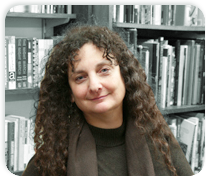
Photo Credit: Gregory Frost
Today we are joined by award-winning editor Ellen Datlow. For more than 30 years, Ellen has edited speculative fiction with a discerning eye, helping to shape the stories and authors we all love to read. Her red pen has explored every corner of speculative fiction, including science fiction, fantasy, and especially horror. Over her career she has edited both novels and short fiction but has developed a stronger passion for short fiction. In 1981, Ellen was promoted to Fiction Editor of OMNI Magazine and held that position for seventeen years, until the magazine, which had evolved into a webzine, folded. She subsequently edited Event Horizon with her former OMNI online colleagues, then edited SCIFICTION, and, currently, acquires and edits short fiction for Tor.com. She edited her first of more than fifty anthologies, The First OMNI Book of Science Fiction in 1984 for Zebra books.
The names of authors she has worked with could fill up your library. Her list of awards includes nine World Fantasy Awards, eight Locus Awards, five Hugo Awards, three Bram Stoker Awards, two International Horror Guild Awards, two Shirley Jackson Awards, the Karl Edward Wagner Award, and the Life Achievement Award from the Horror Writers Association. Ellen will be Guest of Honor at the 71st Annual World Science Fiction Convention that will be held in August 2013. When not peering at her inbox for overdue stories, Ellen spends her time running through the shadows of New York, staking vampires and taunting zombies.
R. K. TROUGHTON FOR AMAZING STORIES: Welcome to Amazing Stories, Ellen. Many editors come to the profession as a byproduct of their writing, but you are counted amongst the group that has no desire to write. Before you started editing at OMNI Magazine, you pursued your calling by enduring a challenging climb through difficult work environments. Please share with us how you first started in publishing and what you experienced along the journey to editor at OMNI.
ELLEN DATLOW: Until I got my first job in publishing I really had no idea how the industry worked or what “editing” meant other than picking stories. I applied for my first publishing job by going through the NYC yellow pages, sending out resumes to any publisher (magazine or book) that I’d heard of or that interested me. I was lucky in that my resume happened to land at Little, Brown & Company’s New York office the day the secretary to the New York salesman was promoted to full time “slush reader”. The office was small enough that I could see what everyone did. The woman I replaced as secretary had so much to read, she let me read some of it in my spare time. So that was my first exposure to anything editorial.
After about nine months I was offered a job (through someone at LB who knew of an opening) at Charterhouse as editorial assistant to Carol Rinzler. Unfortunately, even as she hired me I think she was aware that Charterhouse imprint was going to be absorbed by its parent company. But James Wade, a senior editor at the parent company, David McKay, took me on as his assistant. Unfortunately, a few months later the founders/publishers — Kennett and Eleanor Rawson — plus Jim all walked out, leaving me without a job (while in the hospital with pneumonia)
After several other miserable/or non-productive work-experiences in various editorial departments, I got my first magazine job –with Omni, where I started as Associate Fiction editor for Bob Sheckley. When he left, I was promoted by Ben Bova to Fiction Editor.
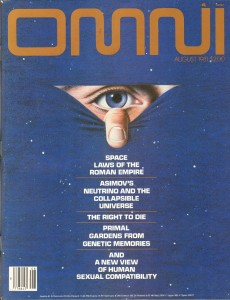 ASM: Your career at OMNI spanned about nineteen years (1979-1998). During your time at one of the most widely read science/science fiction magazines in the world, you worked with many famous authors. What was it like to work at OMNI, and how did you develop as an editor during your tenure?
ASM: Your career at OMNI spanned about nineteen years (1979-1998). During your time at one of the most widely read science/science fiction magazines in the world, you worked with many famous authors. What was it like to work at OMNI, and how did you develop as an editor during your tenure?
ED: I loved working at OMNI. I initially was Associate Fiction Editor under Bob Sheckley from late 1979, for about one and half years. Because neither of us knew the inherent hierarchy of an editorial staff (I doubt that Bob had ever worked in an office before, let alone as an editor.) we worked more as a partnership than we should have. Neither of us knew that the way it usually works is that the editor reads the agented submissions or submissions by already published writers and the assistant (or associate, as I was) generally reads the slush. Instead I read all incoming manuscripts first (or most—once in awhile a friend of Bob’s would hand him a manuscript directly), did all the rejecting, and passed on the works that I liked–deciding with him which stories to buy, and editing most of them. This is the heavy duty period when I learned how to edit on the job.
Bob took a leave of absence over the summer of 1981 in order to write (he’d been blocked, which is why he took the job in the first place) and during those two months I was in charge. When he wanted to take another month off, Ben said no and Bob quit. Ben was hesitant about promoting me because as far as he knew I didn’t have that much experience, but more importantly, I’d be the first non-writer helming the fiction department. Bob and Kathy hired Ben and then Ben hired Bob because their respected names in the sf field would automatically provide an air of respectability to an enterprise funded by Penthouse magazine. However, by 1981, it was clear that OMNI was being embraced by the field (George R. R. Martin’s “The Way of Cross and Dragon” and “Sandkings” both won Hugos in 1980) so I pointed out that having a “big name writer/editor” was no longer necessary. Initially, all my acquisitions had to go through Ben, but that changed shortly before Ben left the magazine in 1981, only several months after I’d been promoted to Fiction Editor.
From the beginning, I went after writers I wanted to publish. I read Roy Torgeson’s Chrysalis series and the Berkley Showcase anthology series, contacting newer writers in them whose work impressed me. I also contacted non-genre writers, some of whom I eventually did publish in OMNI—writers like Joyce Carol Oates, Julio Cortazar, William S. Burroughs, Patricia Highsmith, William Kotzwinkle (pre-ET), and T. Coraghessan Boyle.
As time went on, I became more confident, buying all kinds of stories: sf/f/h and the occasionally story on the edge of genre, feeling that readers would be willing to follow me, even if the occasional story had a minimal fantastic/horrific element; even if they didn’t love every story I published.
 ASM: Over your career you have edited more than fifty anthologies by yourself or with co-editors. Why did you begin creating all these anthologies that have brought us so many memorable stories?
ASM: Over your career you have edited more than fifty anthologies by yourself or with co-editors. Why did you begin creating all these anthologies that have brought us so many memorable stories?
ED: I started editing half original/half reprint anthologies while at OMNI, because I wanted to buy and edit more fiction. As time went on I could only buy a few stories a month—sometimes one or two. I tried to avoid a conflict of interest by starting with a vampirism anthology and an anthology about sexuality and gender, using as the reprints favorite stories, or stories that I wanted to buy for OMNI but couldn’t.
But relatively recently, I’ve come to realize that all the sf/f/h stories I read growing up were in anthologies. I never knew sf magazines existed. So I think that editing anthologies was part of my natural evolution as a short story editor.
ASM: Some might suggest that editors develop a voice through the fiction they accept and how they coach their authors. How would you describe your editing style?
ED: My taste is eclectic, my style hands-on. I’m always willing to work with a writer on a story that I think is almost there with some work (which may involve everything from major revisions or merely some tweaking by the writer).
ASM: This year you successfully ventured into the world of Kickstarter with your anthology Fearful Symmetries, which will hit stores in 2014. Please tell us about the inspiration for using Kickstarter to fund your book and what we can look forward to in the anthology?
ED: Non-theme anthologies in any genre have always been a hard-sell. I’ve previously edited three: Salon Fantastique (fantasy, with Terri Windling) (Thunder’s Mouth); The Del Rey Book of Science Fiction and Horror (Del Rey); and Inferno (horror) (Tor). None did well compared to my other themed, original anthologies. So that was its inspiration.
I’ve so far acquired stories by Terry Dowling, Helen Marshall, Brian Evenson, and Pat Cadigan, all of which were solicited. A few of the writers who had committed to writing stories have had to back out (which is why I always solicit about one third more stories than I know I’ll need). I’m currently reading some of the stories from the open reading period. I’m hoping to include a variety of types and tones. I won’t know how it’ll come out until I’m done reading.
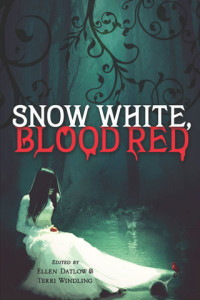 ASM: Snow White, Blood Red edited by you and Terri Windling gave birth to the notion of an adult fairytale. You subsequently co-edited five other anthologies in the series. For those who are not familiar with the concept of adult fairytales, please tell us about the sub-genre and what we can find inside Snow White, Blood Red.
ASM: Snow White, Blood Red edited by you and Terri Windling gave birth to the notion of an adult fairytale. You subsequently co-edited five other anthologies in the series. For those who are not familiar with the concept of adult fairytales, please tell us about the sub-genre and what we can find inside Snow White, Blood Red.
ED: The fairy tale as an adult literary form wasn’t a new idea when Terri thought up the first book. Tanith Lee, Angela Carter, Robert Coover, and other writers were retelling the classic tales in the 1970s. Snow White, Blood Red was first published in 1993. In addition, many original fairy tales were not written for children. They were bowdlerized later. So one could say that with our series we returned fairy tales to their roots, while often providing a contemporary take on a very old story. There’s sex and violence and humor and beauty and ugliness and poetry. There are stories and poetry by Tanith Lee, Neil Gaiman, Jane Yolen, Charles deLint, Steve Rasnic Tem, Melanie Tem, Nancy Kress. Patricia McKillip, Gregory Frost, and eleven other authors.
The book has been my most successful anthology by far, rarely being out of print. It’s currently available in hardcover from the B&N proprietary imprint Fall River Press, and will be available as an e-book for the first time this fall.
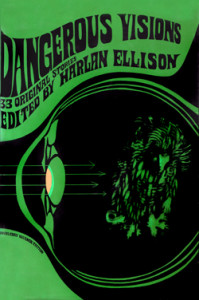 ASM: Many in the world still have not stumbled upon science fiction, fantasy, or horror. What was your first exposure to speculative fiction, and what hooked you for life?
ASM: Many in the world still have not stumbled upon science fiction, fantasy, or horror. What was your first exposure to speculative fiction, and what hooked you for life?
ED: My mother read me fairy tales as a child, then I read Eleanor Cameron’s Mushroom planet books, superhero and monster comic books (well, actually all comic books). The Odyssey, Bullfinch’s Mythology, and Nathaniel Hawthorne’s stories. Later I read Richard Matheson, Ray Bradbury, and Harlan Ellison (the latter’s anthologies, as well as his short fiction). So I was hooked from the get-go. Even though I’ve read “realistic” novels and stories throughout my life, I much prefer those with an edge of otherworldliness, darkness, or outright science fiction, fantasy/supernatural horror.
ASM: Over your career, you have helped authors sculpt manuscripts into gripping stories. You have read perhaps thousands of tales written by hundreds of authors, witnessing firsthand the very best and the very worst the genre has to offer. You have even spent time instructing writers at the Clarion workshops. For the writers reading this interview, what advice would you give them?
ED: Rewrite before you submit anything, but don’t rewrite too much. At some point you must let go and get your fiction out into the world.
Never throw anything away. You can always cannibalize bits of unsuccessful stories or novels.
You’re not a writer unless you write. By this I mean you must make time for your writing no matter what.
ASM: What advice do you have for aspiring editors that would like to break into the industry and learn the fine art of editing?
ED: Volunteer to read some slush piles to see what’s out there and you’ll quickly discern what’s publishable and what’s not (the finer points of selection are a separate issue).
I don’t believe editing can be taught. It’s an innate ability you may not realize you have, and that ability/skill develops over time as you do more and more of it. Much of it is learned on the job.
But the most important thing to remember is that a story submitted to you is not your story. It is the writer’s. Do not impose your voice or ever dictate what the writer must do. This is one reason that I think it’s trickier to be a writer/editor than an editor.
ASM: You have been in the speculative publishing industry for over thirty years across four decades. How has the industry changed since you accepted your first job with OMNI?
ED: A few things I’ll shall throw out here:
The obvious: The number of book publishers and stores have shrunk but more books are being published. Magazines have folded, webzines have come and gone. Print on demand and desktop publishing have made it far easier and cheaper to publish books but the distribution systems are screwed up so it’s harder to get the books out there into stores. E-readers have changed the way some people think about reading.
Fantasy has surpassed science fiction in the number of titles being published. This may be because The future is here, so perhaps it’s more difficult to speculate about it. Or because “big idea” discoveries in technology and science have slowed down.
In horror, Stephen King opened the doors for horror for a time—taking it out of the mainstream stacks as he, Anne Rice, and Dean Koontz ascended into their own bestsellerdom genre then closed the door again for everyone else. Now a lot of horror is being published by mainstream publishers, not announcing the works as “horror.”
J.K. Rowling opened the door to something called “young adult fiction”, something that always existed but had no specific name and made it into a “thing.” And the publishing world “discovered it” so thus, marketed the hell out of it, which it’s still doing.
And probably a half dozen other things I just haven’t thought of.
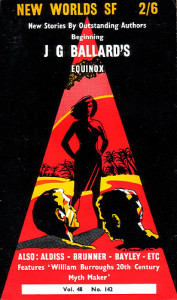 ASM: The speculative fiction industry seems to give more acknowledgment to editors than any other type of fiction. The history of science fiction is filled with iconic figures like John W. Campbell and Hugo Gernsback. Some might say that Gernsback gave birth to science fiction, while Campbell gave it life. The influence of editors is frequently understated and occasionally overblown. Which editors would you point towards as being the most influential in the industry, and what impact did they make?
ASM: The speculative fiction industry seems to give more acknowledgment to editors than any other type of fiction. The history of science fiction is filled with iconic figures like John W. Campbell and Hugo Gernsback. Some might say that Gernsback gave birth to science fiction, while Campbell gave it life. The influence of editors is frequently understated and occasionally overblown. Which editors would you point towards as being the most influential in the industry, and what impact did they make?
ED: There are many in both the novel and short fiction forms, but I’ll mention only three short story editors:
Michael Moorcock for launching a new era of the British Magazine New Worlds, which heralded a brief but shining moment that encouraged science fiction to be more literary (in a good way) and experimental (sometimes in a bad way); Judith Merril because of her annual Best of the Year, which breezily mixed genre and non-genre (and who I’ve taken as one of my inspirations); Shawna McCarthy, who during her brief two year editorship of Asimov’s Science Fiction Magazine shoved the magazine into adulthood, publishing brilliant new writers and powerful, provocative stories.
ASM: As an editor, what things do authors do that inspire you to pull the most hair from your head?
ED: Ignoring instructions/trying to make major changes in their manuscript during the production stages of the publication process.
ASM: For someone who has not read any of your anthologies, where should they start?
ED: That depends on what they’re looking for. Sf/f/h…reprints or new stories, themed anthologies or un-themed.
If they’re interested in checking out what/who is new in horror they might try my Best Horror of the Year. If they’re into fairy tales, they can pick up one of the adult fairy tales series. If they’re interested in young adult fiction they might want to try one of Terri and my mythic series: The Green Man, The Faery Reel, The Coyote Road, or The Beastly Bride. Of Teeth, our anti-sparkly vampire anthology. We’ve also co-edited three middle grade fairy tales books. Off Limits, the follow up to Alien Sex is available as an ebook (both are).
 ASM: What can your fans expect to see from you in the future?
ASM: What can your fans expect to see from you in the future?
ED: The Best Horror of the Year Volume Five is almost out and I’m currently working on The Best Horror of the Year Volume Six for Skyhorse (under its Night Shade imprint).
Early next year Tachyon will publish Lovecraft’s Monsters, a reprint anthology (including one original story) with illustrations by John Coulthart for each Lovecraftian critter in the book.
Chizine will be publishing Fearful Symmetries in 2014. I’ve just finished another reprint anthology, this one on movies –most of the stories exceedingly dark– for Tachyon called The Cutting Room. It’ll be out in early 2015. I’m working on a couple of other horror anthologies which will be out in 2015, I think.
Terri and I have a few ideas for new anthologies and we’re hoping to sell them.
In addition, I’ve recently acquired a Christmas story plus several other stories for Tor.com, all of which will be published next spring.
ASM: Thank you for joining us today. We have long enjoyed your contributions to the industry and eagerly anticipate your next anthology. We look forward to sampling even more of your insights at the 71st Annual WorldCon. Before you go, is there anything else you would like to share with the readers of Amazing Stories?
ED: You’re very welcome-I look forward to seeing everyone at LoneStarCon.











1 Comment